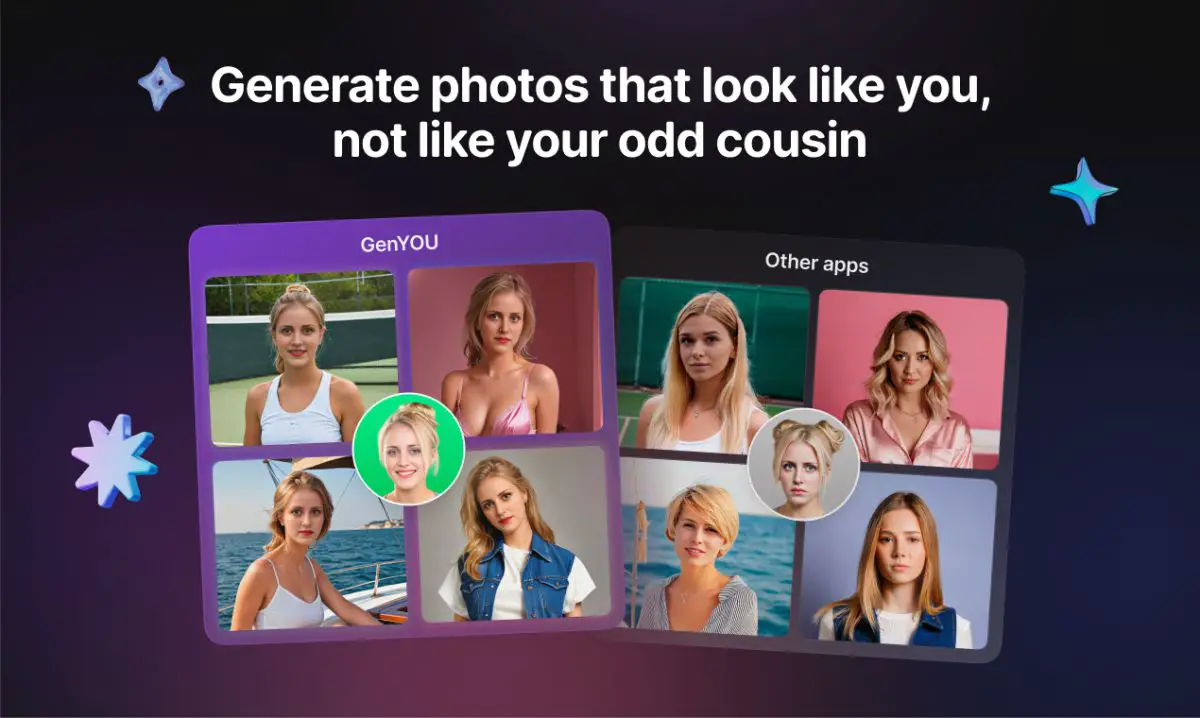Okay, let me be completely honest with you. I’ve been testing AI image generation tools for almost four years now, and most of them are absolute trash. Overhyped, underperformed, and frankly, a complete waste of everyone’s money. But GenYOU from Generated Photos? It’s different. Not because it’s some groundbreaking innovation—it’s not—but because it solves legitimate problems that real businesses deal with every day.
What GenYOU Does (Without the BS)
Here’s what makes GenYOU special: it’s incredibly dull, and that’s precisely why it works. While every other AI tool is trying to generate dragons flying through space or whatever viral nonsense is trending, GenYOU focuses on one thing: creating realistic human portraits. Period. Nothing else.
The technology runs on generative adversarial networks. Sounds super technical, but it’s two AI systems in a perpetual wrestling match. One creates fake faces, the other tries to identify the fakes. After millions of rounds, you end up with a system that’s exceptionally good at creating believable human faces.
You can adjust age, ethnicity, gender, hair color, facial hair, accessories—basically everything you’d control in a traditional photo shoot. But here’s what genuinely impressed me: the controls function. I’ve tested countless AI tools where the settings are more like polite suggestions than actual commands. GenYOU delivers what you request, most of the time.
Real Users Making Real Money
Marketing Teams Are Secretly Addicted
I met with a marketing director at a SaaS company in Austin two weeks ago. Her team was bleeding money—$20,000 quarterly on stock photos and custom photography. That’s $80K annually for images that looked identical to every other tech company’s marketing materials.
“We desperately needed diverse faces for our testimonial pages,” she explained over coffee. “Stock photos made our case studies look completely fabricated. Plus, we kept discovering the same models on competitor websites. Not exactly building credibility.”
GenYOU transformed their entire workflow. Instead of massive, expensive photo shoots, they generate portraits on demand. Need a testimonial from a 38-year-old project manager in Miami? Generate it instantly. Writing about productivity tools for remote workers? Create the perfect representative in minutes.
The cost savings are apparent, but the creative freedom is what sold her. The marketing team now tests different demographic approaches without obliterating their budget.
“Last quarter, we tested five different age demographics in our LinkedIn campaign,” she said. “Traditional photography would’ve cost $15,000. With GenYOU, it cost us $28.”
UX Designers Finally Found Their Solution
A UX designer at a healthcare startup in Portland shared his biggest daily frustration with me: creating realistic user personas without accidentally using someone’s actual photograph.
“I used to burn entire days searching through stock photo databases,” he explained during our Slack conversation. “Trying to find faces that matched our user research demographics. Then I’d worry about using the same photo that appeared in a competitor’s presentation.”
GenYOU eliminated this problem. He generates exactly the person he needs for each persona, specific age ranges, professional appearances, and diverse backgrounds. The faces feel authentic enough for client presentations, but don’t carry the legal complications of real people’s photographs.
His team now creates consistent character representations across all design materials. When presenting user experience flows, the same generated faces appear throughout the entire deck, creating narrative consistency that stock photos never provided.
“My creative director used to complain that our personas looked like a random collection of Facebook profiles,” he laughed. “Now they function as characters in our story.”
Content Creators Are Getting Traction
A wellness blogger with 220K monthly readers told me about her biggest challenge: finding authentic images that represent her incredibly diverse readership.
“Stock photos in the wellness space are genuinely terrible,” she said bluntly during our phone interview. “Either they’re staged meditation poses with people who look like yoga instructors, or they’re the same recycled faces appearing on every health website.”
She discovered GenYOU through a Twitter thread about content creation tools. Now she generates custom portraits that perfectly match her article topics—writing about mental health for working mothers? Generate that exact demographic. Discussing wellness strategies for seniors? Create precisely that audience.
The authenticity factor completely surprised her. “My readers started commenting that they could relate to the people in my images. That never happened with stock photography.”
She showed me side-by-side comparisons. The difference was remarkable. Her old articles featured generic stock photos that screamed “FAKE.” Her new content showcased portraits that looked like real people from her community.
But what caught my attention was when she mentioned experimenting with their sexy ai feature for more stylized content. “It maintains the same quality standards while giving me different aesthetic options,” she explained. “Perfect for certain types of wellness content that need a more sophisticated visual approach.”
E-commerce Teams Are Seeing Actual ROI
A product imagery manager at an online fashion retailer shared his experience with me. Mid-tier brand, nothing revolutionary, but they serve customers aged 25-70. The problem was that their model photography heavily skewed toward younger demographics.
“We were losing mature customers because they couldn’t see themselves represented in our imagery,” he explained. “But organizing photo shoots across all age groups was logistically nightmarish and incredibly expensive.”
GenYOU allowed its team to create representative models across its entire customer base. They generated portraits for different ages, ethnicities, and style preferences, then used these for product mockups and marketing campaigns.
The results were quantifiable: conversion rates increased 31% among customers over 50, and “appropriate for my age” customer service inquiries decreased dramatically.
“For the first time in five years, our mature demographic felt genuinely represented,” he said. “You can’t quantify that emotional connection in spreadsheets, but it shows up in revenue.”
The Technical Truth (No Marketing Spin)
GenYOU works effectively within specific parameters. The portraits look convincing, the resolution is professional-grade, and the generation speed is acceptable. But let’s be completely honest about its limitations.
The tool excels at standard portrait compositions—LinkedIn headshots, customer testimonials, and basic character representations. It struggles with complex poses, dramatic lighting, or highly stylized photography. Need artistic portraits or fashion photography? You still need human photographers. No question.
The faces are entirely synthetic, which creates interesting authenticity questions. Legally, you’re protected (these people don’t exist), but some audiences might react negatively if they discover the imagery is AI-generated. Context matters significantly.
I spent a month testing extensively, generating over 800 portraits across different demographics. Quality is consistently high, but you’ll occasionally get images that feel slightly “off”—usually in the eyes or smile. Not a deal-breaker, but requires some selection.
Strange observation: the system sometimes generates faces that look too perfect. Like, uncanny valley territory. I found myself deliberately choosing slightly imperfect results because they felt more human.
Integration Reality (From Someone Who Tests This Stuff)
GenYOU’s API integration impressed me more than the basic user interface. Companies can embed portrait generation directly into content management systems or marketing automation tools. This capability genuinely transforms how organizations approach visual content creation.
The web interface is functional but unremarkable. Gets the job done without being elegant. For teams generating portraits regularly, the straightforward controls are preferable to complex creative tools.
I observed the Austin marketing team using it during a campaign planning session. They generated 18 different portrait variations in about 30 minutes. Try achieving that with traditional photography.
The Ethics Situation (Yeah, It’s Messy)
Using AI-generated imagery isn’t just a technical decision—it’s an ethical one. While GenYOU creates entirely synthetic faces, transparency about content origins is becoming increasingly crucial.
I’ve observed companies handle disclosure differently. Some prominently label AI-generated content, others integrate it seamlessly without specific disclosure. The approach depends on industry, audience, and brand values.
The platform’s terms of service cover commercial usage clearly, but organizations should develop their AI-generated content policies. What feels acceptable today might not in five years as public awareness evolves.
My perspective? Be transparent when it matters, but don’t overthink it. These faces don’t represent real people, so you’re not exploiting anyone’s likeness. But if your brand values authenticity above everything else, consider reconsidering.
Where This Technology is Heading
GenYOU represents the early stages of a fundamental shift in visual content creation. The technology will improve—better resolution, more realistic features, enhanced customization options. But the bigger change is cultural.
We’re moving toward a world where synthetic imagery becomes commonplace. GenYOU is part of that transition, offering professional-grade solutions for organizations ready to embrace AI-generated content.
The question isn’t whether this technology will become mainstream—it already is. The question is how quickly businesses will adapt their workflows to leverage these capabilities effectively.
My Brutally Honest Assessment
GenYOU solves specific problems effectively. It’s not revolutionary, but it’s professionally competent and commercially viable. For marketing teams, UX designers, content creators, and e-commerce operations, it offers genuine value through cost savings, creative flexibility, and demographic representation.
The platform won’t replace all traditional photography, but it doesn’t need to. It fills a specific niche—professional portrait generation—with enough quality and convenience to justify adoption.
If you’re evaluating AI portrait generation tools, GenYOU deserves serious consideration. Not because it’s perfect, but because it works reliably within its defined scope.
The future of visual content creation is synthetic. GenYOU offers a solid entry point into that future, with practical benefits and limitations clearly defined. Whether that future excites or concerns you is ultimately a question each organization must answer for itself.
But honestly? After four years of testing overhyped AI tools, finding one that works as advertised feels incredibly refreshing.
Disclaimer :
This content is for informational purposes only. AITechtonic.com does not own or operate GenYOU and is not affiliated with Generated Photos. Always verify product details independently before use.

